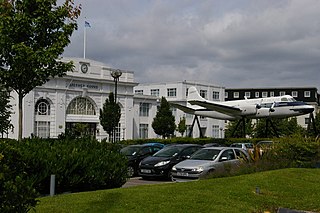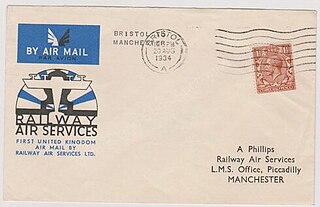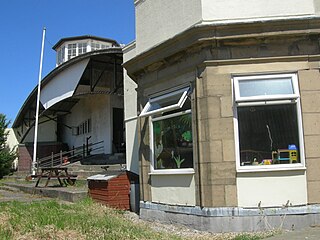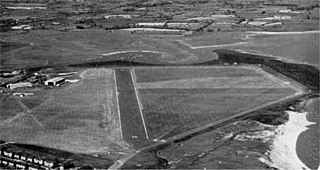
Croydon Airport was the UK's only international airport during the interwar period. It opened in 1920, located near Croydon, then part of Surrey. Built in a Neoclassical style, it was developed as Britain's main airport, handling more cargo, mail, and passengers than any other UK airport at the time. Innovations at the site included the world's first air traffic control and the first airport terminal. During World War II the airport was named RAF Croydon as its role changed to that of a fighter airfield during the Battle of Britain; and in 1943 RAF Transport Command was founded at the site, which used the airport to transport thousands of troops into and out of Europe.

The de Havilland DH.89 Dragon Rapide is a 1930s short-haul biplane airliner developed and produced by British aircraft company de Havilland. Capable of accommodating 6–8 passengers, it proved an economical and durable craft, despite its outdated plywood construction.

The de Havilland Express, also known as the de Havilland D.H.86, was a four-engined passenger aircraft manufactured by the de Havilland Aircraft Company between 1934 and 1937.

British Airways Ltd was a British airline company operating in Europe in the period 1935–1939. It was formed in 1935 by the merger of Spartan Air Lines Ltd, United Airways Ltd, and Hillman's Airways. Its corporate emblem was a winged lion.

Isle of Man Airport is the main civilian airport on the Isle of Man. It is located in the south of the island at Ronaldsway near Castletown, 6 nautical miles southwest of Douglas, the island's capital. Along with the Isle of Man Sea Terminal, it is one of the two main gateways to the island. The airport has scheduled services to the United Kingdom and the Republic of Ireland.

The de Havilland DH.84 Dragon is a successful small commercial aircraft that was designed and built by the de Havilland company.

Railway Air Services (RAS) was a British airline formed in March 1934 by the Big Four railway companies and Imperial Airways. The airline was a domestic airline operating routes within the United Kingdom linking up with Imperial's services.

Heston Aerodrome was an airfield located to the west of London, England, operational between 1929 and 1947. It was situated on the border of the Heston and Cranford areas of Hounslow, Middlesex. In September 1938, the British Prime Minister, Neville Chamberlain, flew from Heston to Germany three times in two weeks for talks with Adolf Hitler, and returned to Heston from the Munich Conference with the paper referred to in his later "Peace for our time" speech from 10 Downing Street.

Hall Caine Airport, also referred to as Close Lake Airfield, was an airfield on the Isle of Man located near the town of Ramsey. It was named after the author Sir Thomas Henry Hall Caine CH, KBE by his sons Gordon Hall Caine and Derwent Hall Caine, who initiated the project, and was the first airport in the British Isles to be named after a person.

Jersey Airways was an airline that operated air services to and from the Channel Islands from 1933 until 1947, when it became part of British European Airways.

Stanley Park Aerodrome was an airfield located in the Stanley Park area of Blackpool, Lancashire, England. It was also known as Blackpool Municipal Airport, and was in use for civil and military flying from 1929 until closure of the airfield in 1947. The site is now used by Blackpool Zoo.

Isle of Man Air Services Ltd (IoMAS) was a small airline, based at Ronaldsway Airport Isle of Man, which operated scheduled flights to the English and Scottish mainland between formation in September 1937 and nationalisation in January 1947.

Bristol (Whitchurch) Airport, also known as Whitchurch Airport, was a municipal airport in Bristol, England, three miles (5 km) south of the city centre, from 1930 to 1957. It was the main airport for Bristol and the surrounding area. During World War II, it was one of the few civil airports in Europe that remained operational, enabling air connections to Lisbon and Shannon and onwards to the United States.
United Airways Ltd was a British airline operating in 1935, ending as part of British Airways Ltd.

Royal Air Force Pengam Moors, or more simply RAF Pengam Moors,, is a former Royal Air Force station and maintenance unit (MU), located on the Pengam Moors area of Tremorfa, situated 2 miles (3.2 km) south east of Cardiff city centre in Wales, from June 1938 to January 1946.
Hillman's Airways was a 1930s British airline which later became part of British Airways.

Hounslow Heath Aerodrome was a grass airfield, operational 1914–1920. It was in the London borough of Hounslow, and hosted the British Empire's first scheduled daily international commercial flights, in 1919. The site today includes the main remaining part of Hounslow Heath.
Scottish Airways was an airline serving most of Scotland, especially the Highlands and Islands. It was active from 1937 until 1947, when it was merged into British European Airways.
North Eastern Airways (NEA) was a British airline which operated from 1935 until the outbreak of World War II in 1939. Based initially in Newcastle upon Tyne, it operated routes from Scotland to London in competition with the railways, retaining its independence to the end.















